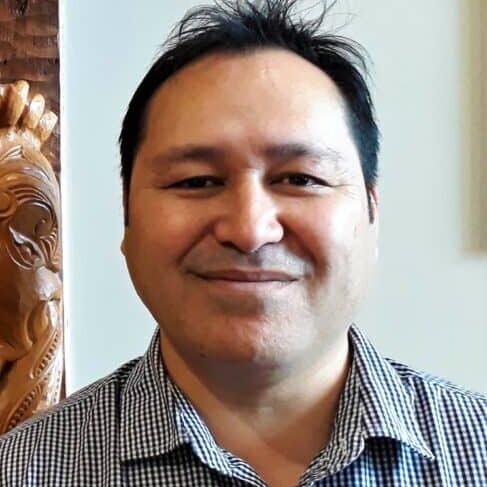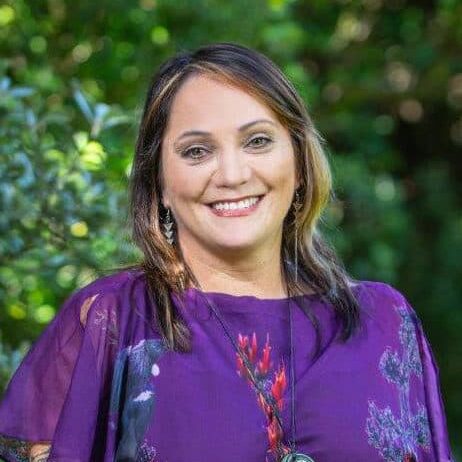Valance Smith
Auckland University of Technology
Te mauri o te rakau, te mauri o te ngahere, te mauri o te tangata: Mātauranga Māori based solutions for kauri dieback and myrtle rust.
The inventory of research outputs and resources can be found here:
Māori worldviews are essential for establishing priorities and allowing the co-production of knowledge in response to threats to taonga rākau (treasured tree) species.
In the fight against kauri dieback and myrtle rust, Māori have been seeking solutions that call on their knowledge systems and understandings of the physical and meta-physical elements of the universe. This includes solutions embedded in the spiritual dimensions of this knowledge, that are vital to the protection and enhancement of the natural environment. These are often overlooked, or at worst subjugated, by conventional environmental management practices and the science knowledge that underpins its decision-making.
Te mauri o te rakau, te mauri o te ngahere, te mauri o te tangata: Mātauranga Māori based solutions for kauri dieback and myrtle rust was a suite of kaupapa Māori projects that aimed to restore the collective health of trees, forests and people. The team did this by connecting to, and resourcing, Māori communities and their environmental knowledge holders to explore solutions embedded in mātauranga Māori (Māori knowledge).
These projects were unashamedly indigenous and collectively showed how mātauranga-led research could contribute to contemporary biosecurity issues, while addressing the aspirations of Māori and their communities.
Māori whakapapa describes how the kauri and tohorā (sperm whale) are brothers, but they were separated when the tohorā chose the ocean over the forest. In this research area we looked at how this connection could possibly help save the kauri from kauri dieback disease.
The team was led by Matua Tohe Ashby and investigated rongoā (traditional medicine) solutions for kauri dieback. This involved tohorā, karakia and mōteatea, and tied into the second Oranga research project: Te reo o te waonui a Tāne. The team also traind kauri communities in rongoā solutions to help save their rākau (trees).
The research team was supported by Te Tira Whakamātaki, He Putanga Kōrero – He Puna Mātauranga and Dr Jamie Ataria.
Led by the Pawarenga community, Dr. Valance Smith and his team collaborated with kaitiaki and leaders from Pawarenga to delve into the realm of ‘ihirangaranga’—vibrations and frequencies—as healing sounds, to construct a sonic tapestry of rejuvenation and well-being.
Nestled amidst the Te Auwarawara forest, the soundscape is a layered composition, intricately woven with sonic samples of healthy kauri within its untouched habitat, the whale song of its cetacean kin the tohora, inlayed with the healing sounds of taonga puoro, takutaku, and karakia, representing profound layers of ancient wisdom and knowledge, deeply ingrained in the very fabric of the soundscape.
In addition, the soundscape of ailing kauri trees has been captured and examined to gather vital baseline data, enabling continuous monitoring and tracking of their healing progress.
This project was supported by an array of mātauranga Māori tools, including pūrākau (oral narratives), maramataka (lunar calendar), and ngā kaupeka (phases of summer and winter) unique to the Pawarenga region. These invaluable resources serve as both treatment modalities and management tools, empowering the community to foster the well-being and vitality of their kauri.
Māori communities often have an intimate relationship with their ngahere (forest), so it only makes sense that they form an intergral part of the effort to protect it. Since the discovery of myrtle rust in Aotearoa in 2017, some research by the Ministry for Primary Industries and BioHeritage National Science Challenge has focused on how iwi, hapū, whānau, Māori organisations and communities could best respond to biosecurity threats. The main findings of this research was the need for Māori to lead their own research and identification of solutions that cater to their needs, not those of other ideologies.
Alby Marsh and our Hapū solutions for myrtle rust team relayed the detailed findings back to hapū around the country and found out how they want to repond to myrtle rust.
The team worked with regional Tangata Māori (Champions) to develop a conservation plan specific for each community. These involved looking at behavioural changes of wild taonga plants as they respond to myrtle rust (such as unexpected flowering), mātauranga Māori based solutions for myrtle rust, and mātauranga surveillance tools.
Seed collection and storage can be a critical conservation strategy when it comes to saving our taonga rākau (treasured trees). But the process must take proper account of mana taonga rākau, mana whenua rangatiratanga (right to exercise authority) and tikanga (correct processes).
This project worked towards reclaiming seed conservation mātauranga (Māori knowledge) and developing collaborative agreements with seed conservation establishments, based on equality, fairness and open knowledge exchange.
Melanie Mark-Shadbolt, Te Taiawatea Moko-Painting and Marcus-Rongowhitiao Shadbolt led the team to co-develop seed conservation protocols that identify knowledge needs and training of indigenous communities. These protocols protect their rights as custodians of taonga species, which is crucial to optimising the long-term disease management of myrtle rust.
The Homiromiro bird flies above the canopy, looking down and seeing both the expanse of forest and the detail of each tree. This is the type of ‘critical friend’ we have embedded in Oranga.
Drs Mariella Marzano (Forest Research, Scotland) and Simon Lambert (Tūhoe, Ngāti Ruapani; Lincoln University) social scientists who facilitated communication between our research projects, and between Oranga and other Ngā Rākau Taketake themes. They evaluated, questiond and made suggestions on our research so we could ensure each research team achieved the best possible outcomes.
As the programme approached its final months our team focused on the remaining objectives, including:

Valance Smith

Melanie Mark-Shadbolt